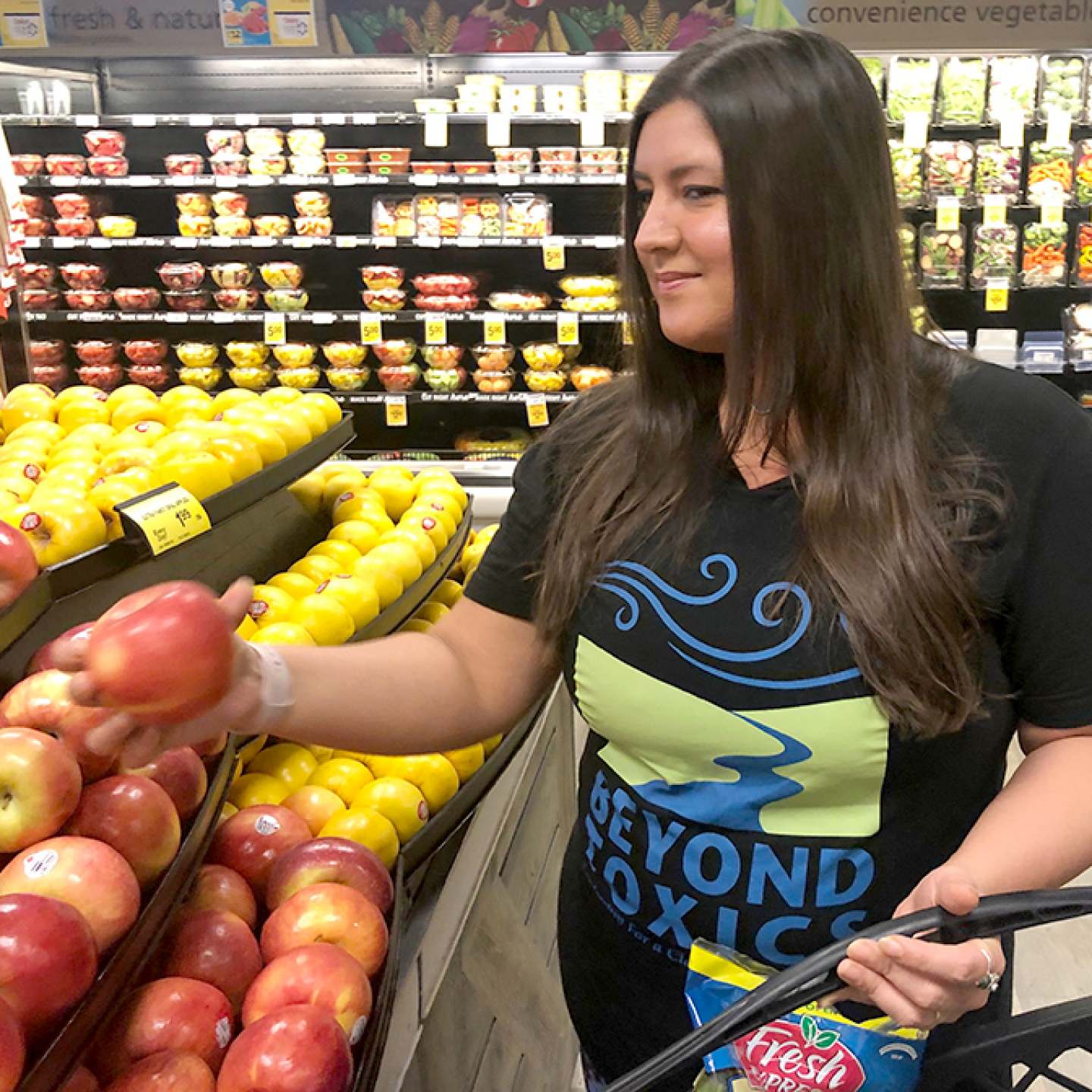This development highlights the power of grassroots action. Oregon’s new law on chlorpyrifos is stronger and more protective than the US EPA.
Clearing the Air: Uncovering the Risks of Gas Stove Pollution
Over the course of one work week, my colleagues on the Beyond Toxics Air Quality team and I visited 14 homes in Eugene and Springfield, toting a FLIR (Forward-Looking Infrared) camera and air quality monitoring equipment. We wanted to “see” what our naked eyes could not: what air toxics are being emitted from gas appliances.
Gas appliances emit two groups of pollutants of concern to us. One, appliances do not burn 100% of the natural gas going into them, and they release unburned methane, ethane, and butane, all of which contribute to global warming. Two, when natural gas is successfully burned, the previously mentioned pollutants turn into CO2, a major climate contributor, and PM 2.5, NO2, volatile organic compounds (VOCs) and other pollutants closely tied to childhood asthma and premature death in adults.
I was asked to tag along to take photos to document the process. I don’t often get to work “out in the field” with the team, so this was an exciting opportunity to work directly with the Air Quality team and learn firsthand the dangers of gas appliances.
Seeing is Believing
I was immediately taken aback by what the camera captured in the first house I visited. I didn’t know what to expect, but seeing plumes of gasses and VOCs spewing into the air was eye-opening. To be perfectly honest, I had never thought much about the use of gas in our home. As a kid, I remember when my family moved into a home with a gas stove, it felt like an upgrade. But now I’m wondering, why do we consider burning fossil fuels in our homes and polluting our indoor air to be an improvement over electricity?

The FLIR camera, often used by professionals to visualize gas leaks, reveals a plume of pollutants emerging from a preheated oven. | Photos by Emily Matlock
After visiting several homes and seeing the same toxic plumes at each, I was thankful for my electric appliances. Admittedly, I’m not much of a cook but it works just fine for my needs. By the end of the day, I had a headache, and I can only imagine it was caused by my exposure to gas and VOCs throughout the day. We simply turned on gas stoves and ovens for several minutes to capture the plumes on the FLIR camera. Imagine cooking every night for a family of four, using every burner and the oven, and inhaling the fumes for the hour or so it takes to prepare a meal.
The residents we spoke to all said similar things: I love cooking with my gas stove, but it’s not worth the risk to my health. Or, after seeing the fumes, I would switch to electric if I could.
And that’s just it, many of us don’t have the choice. My last rental home had gas appliances, but inadequate ventilation above the range. Many homeowners feel that they can’t afford to make the switch, or wouldn’t know where to start.
Choosing a Better Future
We need policy in place to ensure a climate-smart and healthy future. Eugene’s recent ordinance prohibits gas infrastructure in new, low-rise residential construction. It doesn’t take away the choice for buyers to purchase gas appliances or homes, but rather adds electrified homes that will ensure a healthier future for residents and the planet.

Our FLIR video footage reveals the presence of toxic gasses beyond the flame we can see.
The manufactured controversy of so-called “energy choice” is fraught with greenwashing from an industry that doesn’t want to lose its stronghold on a community dependent on fossil fuels. Gas industry profits are made at the expense of those of us who don’t have a choice but to pollute our homes and the environment. The gas industry touts it as “clean” and “natural,” when studies like ours with the FLIR camera clearly show high levels of pollutants and toxins entering the home.
If our study could be replicated on a larger scale, I think many Eugene residents and folks across the country would be surprised–maybe even horrified–to see plumes of unburned methane, VOCs and other toxics coming from their home appliances. Eugene’s gas ordinance is a first step, but Beyond Toxics will continue to educate and provide resources for moving toward a fossil-free future. It’s the only future that makes sense for future generations.

~ Emily Matlock,
Beyond Toxics Membership and Communications Coordinator
Read the NEW Beyond Toxics Report
Seeing is Believing: Visualizing Indoor Air Pollution from Gas Stoves (PDF)
Find out more about Building a Fossil Free Future, our climate justice campaign!
It’s National Public Health Week. Let’s tackle toxic chemicals!
Every child deserves a safe environment to grow in that allows them to become strong and healthy and develop to their full potential. During National Public Health Week, it's important to draw attention to the health impacts and risks from toxic chemicals in products and the places where children live, learn and play. It is now estimated that 10 million synthetic chemicals are added to the marketplace every year. They range from the chemicals in plastic toys, pesticides on our lawns and school grounds, and harmful additives in our personal care products that go directly onto our skin and are absorbed into our organs.
These chemicals can cause immediate and long-term harm. Toxic chemicals are linked to neurological damage which can leave a child with learning disabilities. Over time, chemicals can lead to a wide range of health problems from endocrine and reproductive disruption to cancer. Exposure to harmful chemicals in consumer products and the environment disproportionately impact communities of color and lower income communities that are more often exposed to cumulative toxins. It is often the case that cheaper and deadlier products are marketed to the most vulnerable members of our communities.
What is Oregon doing to address toxic chemicals?
Thankfully, there are three key bills addressing toxic chemicals this 2023 Session being led by Oregon Environmental Council and Beyond Toxics and their partners. We continue to advocate for and defend these bills from staunch opposition from the chemical and pesticide industry and demand that toxics be prioritized by our lawmakers.
This year, National Public Health Week coincides with an important deadline in Oregon’s legislative session, and thus determines what health-protective policies will, or will not, move forward. On April 4th, every bill currently being considered by the Oregon legislature must have been voted out of its first chamber committee.
What do these bills do, and what is their current status?
1) Toxic Free Schools (SB 426)
Oregon school districts and regulatory agencies currently lack funding, coordination and resources needed to implement safer pesticide use practices. As a result, unintentional yet illegal pesticide uses are occurring at Oregon schools. SB 426 will fix a 14-year unfunded mandate for schools and create a path towards modernized record keeping and safer choices for pest control under the Healthy and Safe Schools Act.
The Toxic Free Schools Act will:
SB 426 was voted out of the Senate Education Committee on March 30th and has been referred to the Joint Ways and Means Committee to address its fiscal impact.
Read more about Toxic Free Schools
2) Toxic Free Cosmetics (SB 546)
People assume personal and beauty products (collectively called “cosmetics”) are safe. But it is estimated there are over 10,000 chemicals in the beauty market today, and account for a $100 billion beauty industry. The Federal Food, Drug and Cosmetics Act (FDCA) has only restricted 11 chemicals since 1938, while the European Union has banned over 1800 chemicals.
Through SB 546, Oregon can require the public disclosure of all chemical ingredients on a company’s product webpage. Doing so is an accessible way for consumers to make educated purchasing decisions. Additionally, it will ban the sale of the worst chemicals in cosmetics and personal care products like many other states have.
SB 546 passed out of the Senate Energy and Environment Committee on March 28th, unanimously and bipartisan, and has been referred to the Joint Ways and Means Committee to address its fiscal impact.
Read more about Toxic Free Cosmetics.

Photo courtesy of Tanaphong Toochinda
3) Toxic Free Kids Modernization Act (HB 3043)
Thousands of chemicals lurk in products our kids use every day, and children are far more vulnerable to toxic chemicals than adults. HB 3043 builds on the success of Oregon’s 2015 Toxic Free Kids Act by strengthening protections for children’s health and streamlining business reporting requirements.
A modernized Toxic Free Kids Act will:
HB 3043 passed out of the House Committee on Climate and Energy on March 15th, also unanimously and bipartisan, and subsequently passed the full House 42-14 also on a bipartisan vote, on March 22nd. It heads to the Senate Energy and Environment Committee as its second chamber.
What Can you do?
In your day-to-day life, keep in mind ways that you can buy toxics-free or organic items to reduce your risk of chemical and pesticide exposure. When possible, consider reducing your use of cosmetics or products if you’re sensitive to chemicals. Be sure to wash hands and remove your shoes after playing on school fields.
In addition, contact legislators and urge them to act NOW to regulate toxic chemicals and protect public health for Oregonians. Let them know we are depending on them to help keep our families safe from harmful chemicals and pesticides at home and at school.
Authors:
Jamie Pang, Environmental Health Program Director, Oregon Environmental Council
Lisa Arkin, Executive Director, Beyond Toxics
Victory for Clean Energy
NW Natural Withdraws its Hydrogen-Fracked Gas Blending Project in Eugene

What does it really take to fight for non-polluting and equitable energy choices while calling out greenwashing and false solutions? Beyond Toxics made a decision to step forward to halt an ill-conceived energy project put forward by NW Natural, a corporation that makes its profits by promoting the sale and use of fracked methane gas. Our decision aligns with our environmental justice values, specifically supporting community health and fair treatment.
This October, Beyond Toxics joined with other organizations to intervene in a proposal by NW (Not-so-very) Natural to stop a $10 million project to build an experimental hydrogen-blending facility in West Eugene. Our intervenor status was approved by the Oregon Public Utilities Commission, which would need to approve NWN’s project before any proposal could proceed.
On November 1st, mere weeks after our team intervened in NW Natural’s application, the corporation formally withdrew its application. The cancellation of the methane-hydrogen blending project in West Eugene is a clear victory for community organizing! We were able to see this experimental project for what it was - greenwashing and the continuation of climate-destabilizing fossil fuel infrastructure.
It was important we took immediate action to block NW Natural’s predatory plan to use the Bethel neighborhood for the experimental project. As climate justice advocates, we want to share the facts about why hydrogen is the wrong choice for the Bethel neighborhood, and for Oregon!
The project objective was to send methane-hydrogen blended fuel into 2,273 residences in the Bethel neighborhood in West Eugene, a working class neighborhood. However, Bethel residents weren’t given a choice to opt-out, which meant the project was being forced on unsuspecting residents. As one Eugene elected official told me, “Here in Bethel, we’re their guinea pigs.” In addition to being the test subjects for this controversial project, NWN admits the costs of building out a large new fossil fuel infrastructure would be shifted to Oregon ratepayers.
That is merely the start of why this project is better dead. While NWN’s methane-hydrogen project plans are shelved for now, we are skeptical that they will remain forever buried. Should these plans come back to Lane County, the public must be armed with the knowledge of its potential negative impacts on our community.
Greenhouse Gas
Methane is the most potent greenhouse gas in the short term. Methane has twenty-one times the global warming potential of carbon dioxide. Yet, NWN’s $10 million “blending” project will remain 90-95% methane gas, with only 5-10% hydrogen in the blend. That minimal reduction in methane gas accomplishes next to nothing to reduce methane in the atmosphere where it will continue to swiftly affect the earth’s temperature and climate system.
Dangerously Unstable
The volatile nature of hydrogen makes sending hydrogen into homes highly risky. Hydrogen erodes metal pipes and valves, a process called Hydrogen Embrittlement. This occurs when metals become brittle as a result of introducing hydrogen into pipes and appliances. The degree of embrittlement becomes significant when it leads to cracking. Older appliances in houses may have weaknesses that make it more risky to introduce even modest amounts of hydrogen blended in with natural gas. A recent explosion of hydrogen in North Carolina seriously damaged 60 nearby homes, including making at least one home uninhabitable.
Water Usage
Technological inefficiencies along with green hydrogen’s reliance on freshwater during its production process are very worrisome, particularly because the West Eugene project would be using our drinking water from the McKenzie River. In Oregon, as well as other areas of the world, increasing drought conditions may put thirsty communities in competition with multinational hydrogen corporations for fresh water necessary for human, environmental and agricultural survival. A recent article on hydrogen in Reuters cited an Australian study estimating the upper end of water use at over 21 gallons to create one kg of hydrogen - which is equal to 1 gallon of gasoline in BTU equivalent. That’s a lot of water for very little energy.
Public Health
Blending hydrogen and methane increases emissions of nitrogen oxides (NOx) compared to burning methane alone. This raises the risk of NOx-associated chronic respiratory diseases such as asthma. Furthermore, if hydrogen blends cause pipe embrittlement, there may be increased health risks from carbon monoxide leaks from escaping methane gas.
Economics
Economic concerns being discussed by research firms, such Carbon Tracker (10/20/2022), have warned that up to $100 billion of “dirty” hydrogen investments – those which utilize fossil fuels as a feedstock – could become obsolete as nations move to reduce reliance on gas, particularly in light of the desire to avoid purchasing gas from Russia while it attacks Ukraine. According to Forbes Magazine (7/31/2021), “... many of the companies pushing hydrogen aren’t doing so to save the planet. They’re doing so to save their business models in a time of extreme transition towards greener technologies and e-mobility.”
It seems worthwhile to explore the possibilities for clean hydrogen in fuel cells needed for transportation (after all, hydrogen is rocket fuel) or heavy industrial uses. However, we know that blended hydrogen in homes does very little for public health or to help Oregon achieve its carbon reduction goals. NW Natural's claim that hydrogen is the pathway to “transition” away from fossil fuels for residential use is pure greenwashing. It is clear that their claims are merely a ploy to maintain the status quo for gas companies and keep us chained to fossil fuel infrastructure such as gas pipelines and appliances.
The more we learn, the more we understand that, wherever big natural gas companies peddle hydrogen blending projects, their proposals take us in the wrong direction to realistically meet climate harm reduction goals. For these reasons and more, Beyond Toxics stepped up to successfully stop this risky project. Now we can get back to the business of investing in the emissions reductions we need, and quickly, to protect health and step back from the brink of climate disaster.
Lisa Arkin,
Executive Director
An Apple a Day Brings Pesticides Your Way
Today we’re partnering with Friends of The Earth to help them release a national study revealing unsafe levels of pesticides in commonly purchased grocery store foods, including data from Oregon. During late 2018, Beyond Toxics representatives participated in this research project by shopping at common grocery stores in Oregon, including Costco and Fred Meyer.
Protect Oregon's bees and have a good time doing it!
Important action is being taken across our state to protect honey bees. However, the public is less aware of the critical role Oregon’s native bees play in pollination and maintaining the healthy environment we all enjoy – nor of the threats they face. Did you know eight different species of native bees are currently listed on the United States Endangered Species List?
Strides to Improve Air Quality and Ban Asbestos
Healthy air should be a basic right, but all over the world, people face exposure to toxins that remain unregulated and dangerous. It’s important that the public becomes more educated about these toxins, both in the natural environment and those hidden in consumer products or construction materials within our own homes. With better awareness and education, we can reduce the health risks these toxins pose, and help change the laws that allow the presence of toxic chemicals.
GUEST BLOG: Toxics in our Living Rooms
The comfortable chair that I just bought and sit in for hours each day is giving me a sore throat and making my eyes sting. I know that sounds crazy, but I’ve been experimenting for about a month now, and I can say for certain that after about a half hour of sitting in it – reading, doing my emails, or whatever – my throat starts to feel raw and I need to blink my eyes more. If I get up and move away from the chair, the symptoms dissipate until I go back there, and it starts again. I would just return the chair to the store, but there’s a no return policy. And if it’s actually emitting some sort of harmful chemical or fibers, I don’t want to give it away to an unsuspecting person who, like me, just wants to relax without side effects.
The Bee, the Puppy and You!
This week national environmental leaders in bee protection, including Beyond Toxics, signed on to letters sent to Ace and True Value Hardware stores asking them to act now to protect bees! Our petition is for Ace and True Value to commit to not sell products containing systemic neonicotinoid pesticides harmful to bees, butterflies, birds and other wildlife.

















